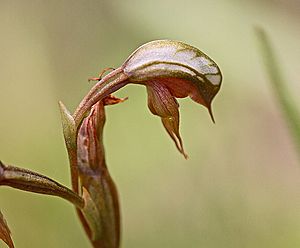Red rustyhood facts for kids
Quick facts for kids Red rustyhood |
|
|---|---|
 |
|
| Pterostylis rufa growing in the Southern Downs Region | |
| Scientific classification | |
| Genus: |
Pterostylis
|
| Species: |
rufa
|
| Synonyms | |
|
Oligochaetochilus rufus (R.Br.) Szlach. |
|
The Pterostylis rufa, also known as the red rustyhood, is a special type of orchid. It belongs to the Orchidaceae family. This plant is only found in south-eastern Australia.
It grows a cluster of leaves close to the ground, called a rosette. From this rosette, it can grow up to fifteen bright reddish-brown flowers. These flowers have clear white parts that look like "windows." They also have a dark brown, insect-like part called a labellum, which is a special lip on the orchid flower. You can find the red rustyhood from southern Queensland down to south-eastern South Australia.
Contents
What Does the Red Rustyhood Look Like?
The red rustyhood is a plant that grows from an underground tuber. It's a perennial plant, meaning it lives for more than two years. It's also deciduous, so its leaves die back in some seasons.
Leaves and Stems
Each plant has a rosette of five to twelve leaves. These leaves are shaped like an oval or an egg. They are about 10 to 30 millimeters (0.4 to 1.2 inches) long. Each leaf is also about 7 to 13 millimeters (0.3 to 0.5 inches) wide.
When the plant is ready to flower, it grows a stem that is 80 to 200 millimeters (3.1 to 7.9 inches) tall. This stem has three to six leaves wrapped around its base.
Unique Flowers
The red rustyhood produces between two and fifteen flowers. Each flower is a bright reddish-brown color. They have clear white areas that let light through. Each flower is about 16 to 20 millimeters (0.6 to 0.8 inches) long. They are also about 5 to 6 millimeters (0.20 to 0.24 inches) wide. Each flower grows on a small stalk called a pedicel, which is 5 to 20 millimeters (0.2 to 0.8 inches) long.
The top part of the flower, called the "galea," is like a hood. It's made from the dorsal sepal and petals joined together. This hood covers the central part of the flower. The dorsal sepal has a thin, thread-like tip up to 2 millimeters (0.08 inches) long.
The side sepals point downwards. They are about as wide as the galea. These sepals are joined for more than half their length. They have narrow tips that are 7 to 8 millimeters (0.28 to 0.31 inches) long. These tips spread out from each other.
The Insect-Like Labellum
The labellum is a special lip on the orchid flower. On the red rustyhood, it is reddish-brown and looks like an insect. It is about 4 millimeters (0.16 inches) long and 2 millimeters (0.08 inches) wide. The "head" end of the labellum is thick. It has many short white hairs. There are also four or five longer hairs on each side of the "body" part.
The red rustyhood usually flowers from September to November.
Where Does the Red Rustyhood Grow?
The red rustyhood is found in many places and is quite common. It grows in open forests and woodlands that have a lot of heath plants. You can often find it in rocky areas where the soil is not very deep.
It grows from the Darling Downs area through eastern New South Wales. You can also find it in different spots across Victoria. Sometimes, it is seen in the far south-eastern part of South Australia.
How Does the Red Rustyhood Reproduce?
The flowers of the red rustyhood are pollinated by tiny insects. These insects are a type of fungus gnat from the Orfelia species. When these gnats visit the flowers, they help the plant make seeds.

